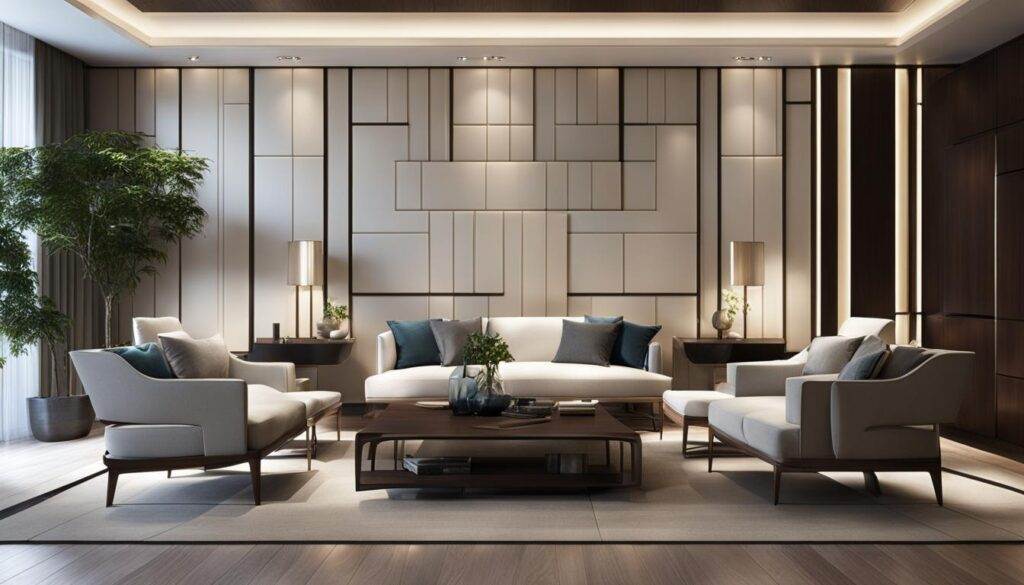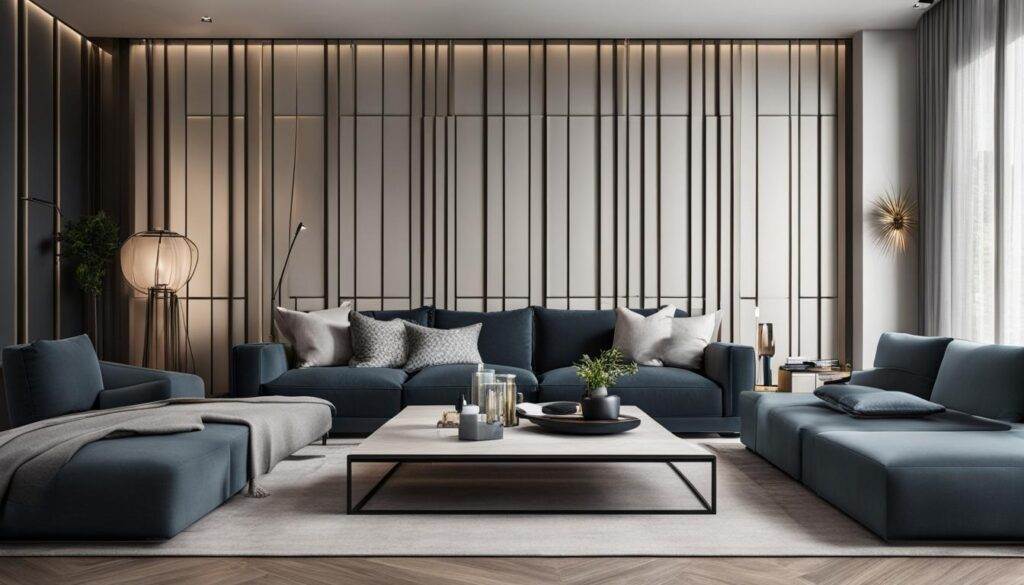Discover the best types of decorative wall panels for interior design, such as wood paneling, MDF panels, and beadboard. Learn how these materials can transform your walls with unique wall finishes, textures, and cladding options.
Types of Decorative Panels
Wall Panel
Wall panels are flat or curved pieces that cover walls. They have been around for a long time, even in ancient times, to make spaces look nice and protect them. From fancy wood paneling in old homes to sleek styles today, wall panels have changed a lot.
Now, in modern interior design, wall panels are super important. They do more than just cover walls; they help define areas, add texture and color, and create eye-catching spots in a room. This makes them popular choices for home interiors.
Benefits of Wall Paneling
- Aesthetic Enhancement: One big plus of wall paneling is how it can change the look of any space. Decorative finishes like textured or patterned panels can really boost a room’s style. Whether you want something cozy or modern, there’s a panel design that fits.
- Durability and Protection: Wall paneling gives extra strength against wear and tear. Many materials used for panels can handle bumps and resist moisture or fire damage. This makes them great for busy areas or rooms that get wet.
- Insulation and Energy Efficiency: Some types of wall paneling can help keep your home warm or cool. This not only makes it comfy but can also save you money on energy bills over time by reducing heat loss.
- Soundproofing Capabilities: Special soundproof or microperforated panels can lower noise levels inside a space. This is especially helpful in home theaters or lively family rooms where keeping things quiet is key.
Best Wall Panelling Materials For Your Home Interiors
Choosing the right material for your wall paneling is important to get the look and function you want.
- Wooden Paneling: Wooden panels bring warmth and character to spaces, making them perfect for cozy living areas. They come in many finishes and styles so homeowners can pick what matches their decor best.
- MDF Paneling: Medium Density Fiberboard (MDF) is flexible and costs less than solid wood. It’s easy to paint or finish, which works well with different design themes while being tough enough for everyday use.
- PVC Paneling: PVC is often picked because it’s resistant to moisture—great for bathrooms or kitchens where it’s humid. Plus, it’s light, which makes it easy to install.
Cost vs. Quality Comparison
When you’re thinking about materials for your walls, it’s good to balance cost with quality:
| Material | Cost Range | Durability | Aesthetic Appeal |
|---|---|---|---|
| Wooden Paneling | High | Very Durable | High |
| MDF Paneling | Moderate | Durable | Moderate |
| PVC Paneling | Low | Moisture Resistant | Moderate |
High-end choices like solid wood might look better and last longer but usually cost more money. Cheaper options like laminate or MDF can still make your space look great without costing too much.
By knowing about different types of decorative panels—like wood, MDF, and PVC—you’ll be able to choose what works best for your home’s interior design while sticking to your budget!
Popular Types of Wall Paneling
Wooden Paneling
Natural wood paneling adds warmth and charm to any room. It’s a favorite choice for interior wall panels because it looks great and lasts a long time. Common types of wood used in wooden paneling include:
- Oak: Strong and has a pretty grain.
- Pine: Light and easy to work with.
- Cherry: Starts bright but gets richer over time.
- Walnut: Dark with beautiful patterns.
Each wood type brings its own style, making it easy to match different designs. But, natural wood can be sensitive to moisture and pests, which is something to keep in mind.
Veneer panels are another option within wooden paneling. They are thin slices of real wood glued onto materials like MDF or particleboard. This gives you the look of solid wood without spending too much money, plus it’s more eco-friendly. Veneer panels can really boost the beauty of your home without emptying your wallet.
MDF Paneling
MDF, or Medium Density Fiberboard, is super popular for wall paneling because it’s flexible and budget-friendly. Made from recycled wood fibers pressed together with resin, MDF has some cool benefits:
- Smooth Surface: Perfect for painting or adding veneer for a custom look.
- Cost-Effective: Usually cheaper than solid wood options.
To keep MDF in good shape, make sure it stays dry so it doesn’t swell up. Use gentle cleaners to keep its surface nice. It’s a smart pick for places where you want a sleek look without spending too much money.
PVC Paneling
PVC paneling is famous for being water-resistant and tough, making it great for damp areas like bathrooms or kitchens. These lightweight panels come in many designs that can look like other materials such as:
- Wood
- Stone
While PVC needs less care than traditional materials, think about its environmental impact since it’s made from plastic. When choosing PVC products, look for companies that focus on sustainability or use recycled materials.
Upholstered Fabric Paneling
Upholstered fabric paneling brings comfort and style into spaces while also helping with sound absorption by soaking up noise. Materials like velvet or linen create a soft feel that makes any room cozier.
When using upholstered panels in your design, think about where they go:
- Bedrooms: Perfect for creating a warm vibe.
- Media Rooms: Great for reducing noise so you can enjoy movies better.
These fabric panels not only make things look nice but also help cut down on noise where it’s needed most.
In short, every type of wall paneling has its own perks that fit different needs and tastes in home design. Whether you love the warmth of wooden paneling, the affordability of MDF, the practicality of PVC, or the cozy feel of upholstered fabric, there’s something out there just right for you!

Creative and Unique Wall Paneling Options
Glass and Mirrored Panels
Glass and mirrored panels are great for modern homes. They add a fresh look while making spaces feel bigger and brighter. Here’s why you might want to use them:
- Brighter Atmosphere: These panels reflect light, which helps small rooms feel larger and more welcoming.
- Visual Effects: The shiny surface can create cool optical illusions, especially when used as accent walls.
- Backlit Options: Backlit glass panels can give your space a soft glow, making it look special.
When using glass or mirrored panels, think about where to place them. Putting them in spots that catch natural light can really brighten up your room.
Metal Paneling
Metal paneling is becoming popular because it’s strong and looks stylish. Here are some things to know about it:
- Types of Metals: Aluminum and steel are common choices that give an industrial vibe.
- Variety of Finishes: You can find different finishes like brushed or patina to match your home’s style.
- Low Maintenance: Metal paneling doesn’t wear out easily, making it a smart choice for busy families.
This kind of paneling works well for feature walls, adding an edgy yet classy touch.
Beadboard and Wainscoting
Beadboard and wainscoting add classic charm to any room. Here’s how they can make your home cozier:
- Texture and Depth: Beadboard has narrow vertical planks that bring texture to walls.
- Elegant Finish: Wainscoting gives a refined look at the bottom of the walls, perfect for dining areas or hallways.
- Style Variety: You can choose from traditional wood finishes or painted styles to fit your decor.
These options help create a warm atmosphere while adding visual interest.
Acoustically Treating the Room
Using special paneling for sound can really improve how a room sounds. Here are some benefits:
- Sound Absorption: Microperforated acoustic panels soak up sound while looking good.
- Ideal Spaces: These panels work great in home theaters or music studios where clear sound is key.
By placing soundproof or acoustic performance panels around the room, you’ll create a space that’s perfect for relaxing or having fun.
Innovative Ideas
When thinking about wall paneling, there are so many creative ideas! Check these out:
- Accent Walls: Use bold colors or patterns that stand out without being too much.
- Half Wall Molding: This adds style while helping separate areas in open spaces.
- Disguised Doors: Match door designs with the wall panels so they blend in nicely instead of standing out awkwardly.
Try different textures and materials while keeping both looks and function in mind for unique designs that show off your personal style!

Using Wall Paneling in Creative Ways
Accent Walls
Creating an accent wall with decorative panels can really change how a room feels. When you pick a bold color or a unique texture for your wall paneling, it becomes the focus of the room. This can make your space feel more inviting and stylish. Here are some popular options:
- Wood Wall Panels: These bring warmth and a rustic charm to any room.
- Mirrored Panels: They help create an illusion of depth, making small spaces feel larger.
- MDF Panels: Medium-density fiberboard is easy to work with and very versatile.
- Upholstered Fabric Panels: These add softness, making them great for bedrooms or living rooms.
- Textured Wall Panels: They come in various designs and add visual interest.
To get the best results:
- Pick a wall that naturally catches attention, like one behind a sofa or bed.
- Try different materials like MDF or upholstered fabric for added comfort.
- Use contrasting colors to make your accent wall pop even more.
Mix and Match
Mixing different types of wall paneling can lead to fun and personalized designs. You can blend textures and finishes for a unique look. Here are some ideas:
- Combine wooden paneling with metal accents for an industrial feel that still feels warm.
- Pair laminate panels with upholstered fabric to introduce different textures that catch the eye.
When mixing materials, keep these tips in mind:
- Stick to a cohesive color palette so everything looks good together.
- Balance heavier materials with lighter ones so the space doesn’t feel crowded.
- Create zones within larger areas by using different panel types smartly.
Innovative Ideas
There are many creative ways to use decorative panels beyond just walls! Here are some cool ideas:
- Half Wall Molding: This combines painted walls with wood paneling for extra dimension without covering everything.
- Decorative Panels Over Tiles: In kitchens or bathrooms, this makes cleaning easier while giving a fresh look.
- Disguise Doors: You can hide doors by blending them into your panel design; this makes transitions smooth throughout your home.
Other fun applications include extending paneling onto ceilings or using room dividers made from unique panels to define spaces without closing them off.
By exploring these creative ways to use wall paneling—like accent walls or innovative designs—you can greatly enhance your interior spaces while showing off your personal style!

